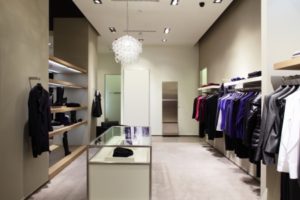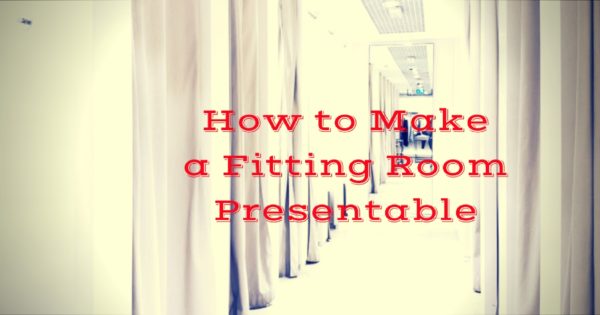We’re on a mission to help you understand how to make fitting rooms better. This is the first of a three-part series intended to provide the basics of a great fitting room experience. The initial focus is on ensuring fitting rooms are presentable.
If you have been following along with us for a little while, you’re probably starting to come around to the idea that fitting rooms are important. Really important. Because this tiny room is where the customer makes their buying decision, it’s really one of the most critical elements to retail success.
And yet the fitting room, where the success or failure of the retail transaction hangs precariously in the balance, is often among the most neglected areas of the store. Think about it:
Is there another area of the store that’s so completely void of technology, either to support the fitting room process or to collect invaluable consumer data?
Once you accept that the current approach to the fitting room experience is, in most cases, completely broken, you can start doing something to address it.
Design a “fit” Fitting Room

For such an important area of the store, most fitting rooms are pretty appalling. It’s hard to feel excited about buying new clothes when you’re standing half-dressed in lackluster lighting conditions.
TWEET: There are dozens of ways to improve #retail fitting rooms. Start with the Big 5.
From choosing the right paint color to having proper doors instead of curtains, there are dozens of things you can do to improve the fitting room experience. In our opinion, these are the big five:
- Size Matters. Make sure it’s large enough to turn around in, even for a larger person. Better still; try to have enough room for more than one person. Unless you also have an on-site babysitter, parents can’t try on clothes without their kids!
- Have a Seat. You can’t try on clothes with your shoes on, and you can’t untie your shoes without somewhere to sit. Well, you can, but not gracefully.
- Get Hooked. Have hooks or hanging rods so customers don’t have to choose between putting your clothes on the floor, or theirs.
- Ditch Overhead Lights. Nobody looks good under harsh, fluorescent lights from above. Damaging a customer’s self-esteem is detrimental to the sales process!
- Mirror, Mirror. Many fitting areas have a shared mirror outside the actual rooms. Customers are reluctant to let the world see them in a new outfit before they’ve had a chance to see it themselves.
If you get these five things right in your fitting rooms, you will be well ahead of the game. None of these will matter, though, if you don’t keep them clean. This brings us to our next point, defining the fitting room service process.
Here’s the bottom line. Be creative with fitting room design, but make sure you remember what their purpose is – an environment conducive to making a buying decision! Create an environment that is brand right, clean, secure, and comfortable! – Fit Happens
[xyz-ihs snippet=”MOFU-Fit-Happens-button”]
Define the Fitting Room Service Process
Once your fitting rooms are in order, or at least they’re not sending customers away crying, it’s time to evaluate the service process. All interactions with customers on the sales floor should have the fitting rooms in mind. “Can I help you find anything?” turns into “Can I get a fitting room started for you?”
This not only helps to guide the customer through the decision-making process, it gives the sales associate the opportunity to make sure the fitting room is cleared of the discards of previous shoppers.
When approaching the customer to set up a fitting room, it’s a perfect time to engage the customer in a conversation. This lends itself to upsell or cross sell opportunities, and lets associates share the details of loyalty programs without being seeming pushy.
Once customers are in the fitting room, don’t leave them hanging! Customers must have an easy way to request different colors and sizes from your sales associates. In many stores, sales associates have tried to address this by knocking on the door to see if the customer needs help. That puts the customer on the associate’s timetable instead of the other way around. What’s a better alternative? We’re glad you asked!
Implement Technology and Use the Data
First and foremost, fitting rooms need call buttons. When customers want assistance in the fitting room, they want it NOW. That’s to your advantage because you can collect valuable data about your customers and their shopping habits based on what they take into the fitting room, and what they leave behind.
When you pair fitting room call button usage data with the kind of tracking that comes with RFID tagging, you can develop a sound understanding of what’s happening in the store, at all times.
This is the kind of data you need to make major changes at the store level. Like, for example, convincing “The Powers That Be” that you need dedicated fitting room associates!
Allocate Payroll to the Fitting Room
If the fitting room is the area where a customer is making a purchase decision, and it’s also an area where they’re most likely to need assistance while half-naked, does it make sense to leave them in there all alone?
Well-trained fitting room associates can be an invaluable part of the sales team. Someone should be with a customer on the way to try something on to let them into a locked fitting room, and to provide service at the moment of truth.
If you look at door traffic alone, the numbers might not justify the expense of dedicating an associate to the fitting rooms. It’s false economy to send customers into the fitting room unattended when we know those who receive service in the fitting room spend dramatically more than those who do not.
Friendly, caring assistance – This is much different from the associate who counts the items the shopper brings into the fitting room and hands a neon 3 on the door handle or the young person with the key to the fitting room who begrudgingly open the locked door. We all know those are security guards – not sales associates. We are talking about the person who brings a size 12 when we can’t wiggle into a size 10, who is happy to bring the gray sweater instead of the black one and the one who brings a matching belt, necklace or jacket to our attention when we say we like an item. They convert many single item purchases into a full market basket. – Flora Delaney, Delaney Consulting
However, if you can’t convince “The Powers That Be” to invest in fitting room associates, technology can provide you a solution.
[Tweet “How to Make a #FittingRoom Presentable @alerttechinc”]
Stay Ahead of the Curve
When a customer heads to the fitting room, there’s simply too much at stake to leave things to chance. Making sure your fitting rooms are presentable and sales associates are available is the first step to providing a great fitting room experience for your customers. In our next post, we’ll talk about refining the fitting room process.
We’ve only scratched the surface with the information provided in this three-part series, but you can learn more about what turns an average fitting room into a great one in the book, “Fit Happens.” Download your free chapter today.
[xyz-ihs snippet=”Fit-Happens-CTA”]

